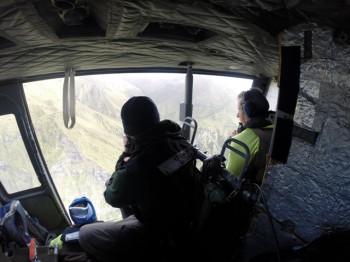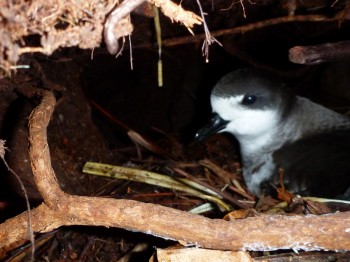The first aerial photographic survey of Endangered Atlantic Yellow-nosed Albatrosses Thalassarche chlororhynchos on the United Kingdom’s Gough Island in the South Atlantic was undertaken on 27 September this year during incubation time as part of South Africa’s annual relief of its weather station on the island. The survey team consisted of Alex Bond of the UK’s Royal Society for the Protection of Bird’s Centre for Conservation Science (with financial support from ACAP’s grant awards for 2014), and Peter Ryan, Delia Davies and Ben Dilley of the FitzPatrick Institute, University of Cape Town, South Africa.
The need for an island-wise survey was identified by ACAP’s Advisory Committee at its 2013 meeting (AC7) in La Rochelle, France, given that previous estimates have been based on ground work only, which does not allow access to all the rugged island’s breeding sites.
A Bell 212 helicopter operated by Starlite Aviation was used for the survey, flying from South Africa’s Antarctic supply and research vessel, the S.A. Agulhas II. The single flight lasted about 25 minutes. Not all areas of the island were covered due to low cloud in the west. Three observers used hand-held cameras through an open door to obtain multiple sets of photos. In addition, two GoPro cameras were fitted below the helicopter with the aim of helping orientation and the merging of photos.

Atlantic Yellow-nosed Albatross on Gough Island, photograph by Andrea Angel and Ross Wanless

The view from the helicopter during the survey, photograph by Delia Davies
According to Alex Bond work has now started to merge the overlapping aerial photos using software to form photomontages, capitalising on recent advances in imaging quality and processing. Apparently occupied nests (AONs) can then be relatively accurately counted from these montages on-screen. However, because of Gough’s thick vegetation in places, some occupied nests will not show up on aerial photographs so extensive ground truthing has been undertaken on the island to allow for correction factors to be applied.
Poor flying weather halted a similar survey planned for the main island of Tristan da Cunha from going ahead. This has now been rescheduled for September 2015. Tristan is thought to be the largest breeding site for the Atlantic Yellow-nosed Albatross, but the most recent population estimate (16 000-30 000 breeding pairs) dates as far back as the early 1970s.
Click here to read more of the RSPB’s conservation work in the Tristan da Cunha group of islands.
Research and monitoring of albatrosses in the Tristan-Gough Islands are supported financially and logistically by ACAP, UK's Darwin Initiative, the South African Department of Environmental Affairs and National Research Foundation and Ovenstone Agencies and takes place with the approval of the Tristan Conservation Department.
With thanks to Alex Bond and Peter Ryan for information.
Selected Literature:
Cuthbert, R.J., Cooper, J. & Ryan, P.G. 2014. Population trends and breeding success of albatrosses and giant petrels at Gough Island in the face of at-sea and on-land threats. Antarctic Science 26: 163-171.
Cuthbert, R., Ryan, P.G., Cooper, J. & Hilton, G. 2003. Demography and population trends of the Atlantic Yellow-nosed Albatross. The Condor 105: 439-452.
John Cooper, ACAP Information Officer, 29 October 2014

 English
English  Français
Français  Español
Español 


